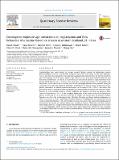Files in this item
Cosmogenic exposure age constraints on deglaciation and flow behaviour of a marine-based ice stream in western Scotland, 21–16 ka
Item metadata
| dc.contributor.author | Small, David | |
| dc.contributor.author | Benetti, Sara | |
| dc.contributor.author | Dove, Dayton | |
| dc.contributor.author | Ballantyne, Colin K. | |
| dc.contributor.author | Fabel, Derek | |
| dc.contributor.author | Clark, Chris D. | |
| dc.contributor.author | Gheorghiu, Delia M. | |
| dc.contributor.author | Newall, Jennifer | |
| dc.contributor.author | Xu, Sheng | |
| dc.date.accessioned | 2017-05-08T09:30:15Z | |
| dc.date.available | 2017-05-08T09:30:15Z | |
| dc.date.issued | 2017-07-01 | |
| dc.identifier | 249950496 | |
| dc.identifier | 68429e76-7248-4ce1-aba7-474ad3a79033 | |
| dc.identifier | 85018730249 | |
| dc.identifier | 000403997900003 | |
| dc.identifier.citation | Small , D , Benetti , S , Dove , D , Ballantyne , C K , Fabel , D , Clark , C D , Gheorghiu , D M , Newall , J & Xu , S 2017 , ' Cosmogenic exposure age constraints on deglaciation and flow behaviour of a marine-based ice stream in western Scotland, 21–16 ka ' , Quaternary Science Reviews , vol. 167 , pp. 30-46 . https://doi.org/10.1016/j.quascirev.2017.04.021 | en |
| dc.identifier.issn | 0277-3791 | |
| dc.identifier.other | RIS: urn:D757CDC230D7FA9C90015B65F430DF15 | |
| dc.identifier.uri | https://hdl.handle.net/10023/10720 | |
| dc.description | This work was supported by the Natural Environment Research Council consortium grant; BRITICE-CHRONO (NE/J009768/1). Analysis was supported by the NERC Cosmogenic Isotope Analysis Facility allocations 9139.1013 and 9155.1014. | en |
| dc.description.abstract | Understanding how marine-based ice streams operated during episodes of deglaciation requires geochronological data that constrain both timing of deglaciation and changes in their flow behaviour, such as that from unconstrained ice streaming to topographically restricted flow. We present seventeen new 10Be exposure ages from glacial boulders and bedrock at sites in western Scotland within the area drained by the Hebrides Ice Stream, a marine-based ice stream that drained a large proportion of the former British-Irish Ice Sheet. Exposure ages from Tiree constrain deglaciation of a topographic high within the central zone of the ice stream, from which convergent flowsets were produced during ice streaming. These ages thus constrain thinning of the Hebrides Ice Stream, which, on the basis of supporting information, we infer to represent cessation of ice streaming at 20.6 ± 1.2 ka, 3–4 ka earlier than previously inferred. A period of more topographically restricted flow produced flow indicators superimposed on those relating to full ice stream conditions, and exposure ages from up-stream of these constrain deglaciation to 17.5 ± 1.0 ka. Complete deglaciation of the marine sector of the Hebrides Ice Stream occurred by 17–16 ka at which time the ice margin was located near the present coastline. Exposure ages from the southernmost Outer Hebrides (Mingulay and Barra) indicate deglaciation at 18.9 ± 1.0 and 17.1 ± 1.0 ka respectively, demonstrating that an independent ice cap persisted on the southern Outer Hebrides for 3–4 ka after initial ice stream deglaciation. This suggests that deglaciation of the Hebrides Ice Stream was focused along major submarine troughs. Collectively, our data constrain initial deglaciation and changes in flow regime of the Hebrides Ice Stream, final deglaciation of its marine sector, and deglaciation of the southern portion of the independent Outer Hebrides Ice Cap, providing chronological constraints on future numerical reconstructions of this key sector of the former British-Irish Ice Sheet. | |
| dc.format.extent | 17 | |
| dc.format.extent | 9218562 | |
| dc.language.iso | eng | |
| dc.relation.ispartof | Quaternary Science Reviews | en |
| dc.subject | Exposure dating | en |
| dc.subject | Marine ice stream | en |
| dc.subject | British-Irish ice sheet | en |
| dc.subject | Deglaciation | en |
| dc.subject | GE Environmental Sciences | en |
| dc.subject | QE Geology | en |
| dc.subject | NDAS | en |
| dc.subject | SDG 14 - Life Below Water | en |
| dc.subject.lcc | GE | en |
| dc.subject.lcc | QE | en |
| dc.title | Cosmogenic exposure age constraints on deglaciation and flow behaviour of a marine-based ice stream in western Scotland, 21–16 ka | en |
| dc.type | Journal article | en |
| dc.contributor.institution | University of St Andrews. School of Geography and Geosciences | en |
| dc.contributor.institution | University of St Andrews. Geography & Sustainable Development | en |
| dc.identifier.doi | 10.1016/j.quascirev.2017.04.021 | |
| dc.description.status | Peer reviewed | en |
This item appears in the following Collection(s)
Items in the St Andrews Research Repository are protected by copyright, with all rights reserved, unless otherwise indicated.

